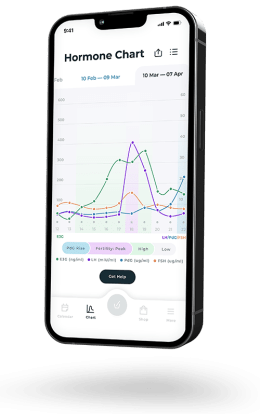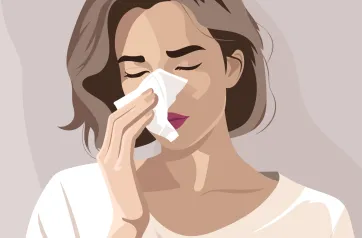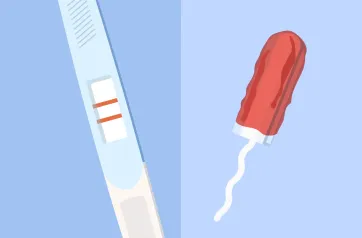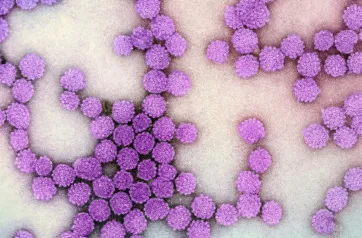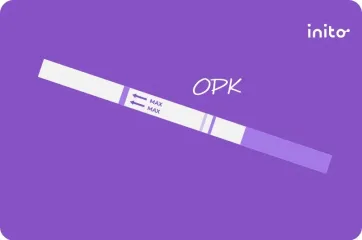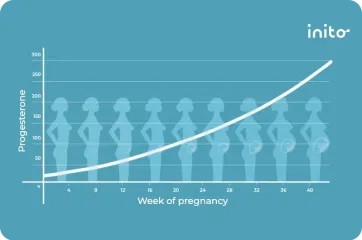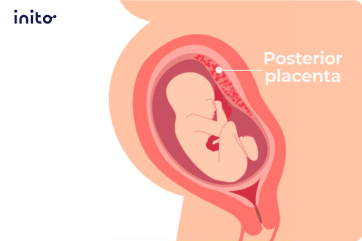Content table
Feeling like your body is out of sync? Maybe you’re dealing with frustrating acne, unwanted hair growth, or irregular periods. And you’re not sure why.
You’re not alone in this, and there could be a hormonal reason behind it. One possibility is high testosterone.
While testosterone is often called a “male hormone,” women make it, too. The key is balance. When these hormone levels get too high, it can throw things off. This is a surprisingly common issue. It affects about 5-10% of women of reproductive age.
The most common reason for high testosterone in women is Polycystic Ovary Syndrome (PCOS). But other conditions can also be the culprit.
Looking to learn more about what this means for you? Let’s explore.
Key Takeaways
- High testosterone is a common hormonal disorder. It’s when women have an excess of androgens (often called male hormones).
- The most common underlying cause of high testosterone is polycystic ovary syndrome.
- Symptoms include irregular periods, acne, excessive hair growth on the face and body (hirsutism), thinning hair on the head (male pattern baldness), and fertility issues.
- Congenital adrenal hyperplasia could be another cause of high testosterone levels.
- Insulin resistance is closely linked to high testosterone. When your body doesn’t use insulin well, it can signal your ovaries to produce too much testosterone.
- Treatment options are available to help manage symptoms and treat high testosterone.
- Treatments include:
- Lifestyle changes, like weight loss, exercise, and sleep
- Medications, like oral contraceptives (birth control pills) or spironolactone
What Is Testosterone, and Why Do Women Need It?
When you hear “testosterone,” you probably think of men. It’s known as the main male sex hormone. But it’s a crucial steroid hormone for women’s health, too.
Think of your body’s hormones as a team of messengers — the body’s chemical messengers that all need to work together. Testosterone is an important player on that team.
In women, testosterone is produced in small amounts by the ovaries and the adrenal glands (these are small glands that sit on top of your kidneys).
Testosterone is key to your overall health. Here’s a quick look at what it does in women:
- Builds strong bones and muscles: Testosterone helps maintain bone density and also increases muscle mass.
- Keeps your body running smoothly: It contributes to red blood cell production, brain function, and heart health.
- Supports libido: It helps regulate your sex drive. Low libido can be a sign of hormonal imbalance.
- Helps create other hormones: Your body uses androgens like testosterone to make estradiol, the key female sex hormone.
So while you only need a little bit, testosterone is a key part of your hormonal puzzle.
What Are Normal Testosterone Levels in Women?
You’re probably wondering how much testosterone is normal. Doctors measure this with a testosterone test, which looks at the total amount in your blood.
Normal testosterone levels typically range from 15 to 70 nanograms per deciliter (ng/dL). (This is for premenopausal women.)
It’s important to know that these levels aren’t static. They change throughout your life and even throughout your menstrual cycle.
Female testosterone levels usually peak when you’re in your 20s. After 30, they start to decline. And this decline ramps up as you approach menopause. Your levels also get a little boost and peak during ovulation each month.
When Is Testosterone Considered Too High?
Your testosterone levels are generally considered high if they go above the normal range of 70 ng/dL.
But, it’s not just about the numbers. The amount of “free” testosterone also matters.
Most testosterone in your blood is attached to a protein called Sex Hormone-Binding Globulin (SHBG). You can think of SHBG as a taxi service for hormones.
When testosterone is riding in the SHBG taxi, it’s not active. The testosterone that isn’t attached is called free testosterone. And it’s this type that can cause symptoms when there’s too much of it.
Normal free testosterone levels in females are very low. Even a small increase can cause noticeable changes. One study estimated that free testosterone levels (5th to 95th percentiles) were 1.2–6.4 pg/mL.
How Do Doctors Diagnose High Testosterone?
If you’re worried about high free testosterone, the first step is to talk to a doctor. They won’t diagnose it based on a single number. Instead, they’ll gather clues from different sources.
Here’s what you can expect for a diagnosis.
1. Conversation about your health
Your doctor will ask about your medical history and the symptoms you’re experiencing.
They’ll want to know about your menstrual cycle, any changes in skin or hair, your overall health, and fertility issues (if any).
2. Physical exam
Next, your doctor will perform a physical examination. They will look for physical symptoms or signs of high testosterone.
These signs include excess body hair, acne, male-pattern hair loss, and any other changes.
3. Blood test
If your doctor suspects a hormone imbalance, they’ll order a blood test. This test will measure your total and sometimes your free testosterone levels. This helps confirm if you have elevated testosterone. They may also prescribe other tests based on your symptoms.
4. Imaging tests
In some cases, your doctor may need more information.
If they think polycystic ovarian syndrome (PCOS) might be the cause, they may suggest an ultrasound. This allows them to look at your ovaries and ovarian follicles.
If they suspect an issue with your adrenal glands, they might order an MRI.
Know more: Fertility Tests for Women
What Are the Signs of High Testosterone in Women?
When you have excess testosterone, your body will often show clear signs.
High testosterone symptoms can range from mild to severe in women. And they can impact you both physically and emotionally.
Here are some of the most common signs of high testosterone in women:
- Irregular periods
- Excess hair growth (hirsutism)
- Acne and oily skin
- Thinning hair on your head
- Changes in body shape
- Voice deepening
- Enlarged clitoris
- Mood swings
- Weight gain
- Fertility issues
If you’re noticing several of these symptoms, it’s time to check with your healthcare provider.
What Causes High Testosterone in Women?
There are a few key conditions that are known causes of high testosterone. These include:
Polycystic Ovary Syndrome (PCOS)
The most common cause of high testosterone in women is polycystic ovary syndrome (PCOS).
It’s estimated that between 60 and 80% of women with polycystic ovary syndrome have high levels of androgens. This is a condition called hyperandrogenism. The main androgens involved are testosterone, androstenedione, and DHEA-S.
In PCOS, the ovaries don’t work as they should. They may develop many small, cyst-like sacs which remain immature due to too much androgen.
This hormonal imbalance is what leads to polycystic ovary syndrome symptoms, which can look like:
- Irregular periods or no periods
- Facial hair growth
- Excess body hair
- Acne
- Fertility problems
- Weight gain or obesity
- Resistance to insulin
Know more: PCOS And Pregnancy: All You Need To Know
Congenital Adrenal Hyperplasia (CAH)
A less common cause of excess testosterone is Congenital Adrenal Hyperplasia (CAH).
In CAH, the body is unable to make hormones like cortisol due to genetic mutations in certain enzymes. Because your body can’t make enough cortisol, the pituitary gland sends signals to the adrenal glands to work harder.
This causes the adrenal glands to get bigger (hyperplasia). And, in the process, they end up with excess adrenal androgen production.
Most severe forms of CAH are usually diagnosed in babies.
But, a milder form may not be discovered until the teenage years or adulthood. This is because it’s not until this time that symptoms appear, such as:
- Irregular periods
- Unwanted body hair growth
- Deepening voice
- Enlarged clitoris
- Acne
Treatment for CAH often involves taking a steroid hormone to replace the hormones that are missing.
Insulin resistance
This is a condition where your body’s cells don’t respond to insulin. This key hormone helps control your blood sugar.
It’s a main feature of both polycystic ovary syndrome and type 2 diabetes. And, it’s strongly linked to high testosterone in women.
High levels of insulin can lower your levels of SHBG (the “taxi” protein we talked about earlier). With fewer SHBG “taxis” available, more testosterone is free and active in your body. This is what leads to high free testosterone levels in females.
Research has shown a clear link: improving insulin sensitivity can help lower testosterone.
In rare cases, high testosterone can be caused by ovarian tumors or adrenal tumors.
How To Lower Testosterone in Women
The good news is that if you have high testosterone, you don’t have to just live with the symptoms. There are effective ways to treat high testosterone and bring your body back into balance.
Lifestyle changes
For many women (especially those with PCOS and insulin resistance), lifestyle changes can make a huge difference.
The biggest one? Weight loss.
If you’re overweight, losing just a small amount of weight can have a powerful effect. Research shows that losing 2-5% of your body weight can help:
- Lower androgen levels
- Improve insulin sensitivity
- Make your periods more regular
Know more: Common PCOS Treatment Options for Better Fertility
Medications
If lifestyle changes aren’t enough for PCOS or insulin resistance, or you have severe symptoms, your doctor may recommend medication. Additionally, medications are required for managing CAH.
Birth control (oral contraceptives)
For women who are not trying to get pregnant, hormonal contraceptives are usually the first choice.
Oral contraceptives work in several ways to lower testosterone:
- They suppress signals from the pituitary gland, which tells the ovaries to produce less testosterone.
- They increase the amount of SHBG, which means less free testosterone is floating around.
- They can also slightly reduce adrenal androgen production.
Know more: Post-Pill PCOS: Can Birth Control Actually Cause PCOS?
Spironolactone
Spironolactone is a diuretic (a water pill) that also has a powerful anti-androgen effect. It works by blocking testosterone from doing its job and by slowing down the body’s production of testosterone.
Spironolactone is especially helpful for treating the physical symptoms of androgen excess, like hirsutism and acne.
Know more: Spironolactone for PCOS: Benefits and Fertility Tips
Metformin
Metformin is a medication designed to improve insulin sensitivity.
By helping your body use insulin more effectively, it can lower insulin levels in your blood. This, in turn, can lead to lower testosterone production from the ovaries.
Metformin is particularly helpful for women with polycystic ovary syndrome who also have resistance to insulin.
Know more: Metformin for PCOS: Fertility Benefits You Need to Know
Glucocorticoids
This type of hormone/testosterone therapy is specifically for those with Congenital Adrenal Hyperplasia (CAH).
Glucocorticoids help replace the cortisol your body is missing. This signals your adrenal glands to stop overproducing adrenal hormones, including androgens.
Dealing with the symptoms of high testosterone in women can be challenging. But it’s important to remember that you have options. It’s a manageable condition, and the first step is understanding the underlying cause.
Whether it’s PCOS, CAH, or another issue, a proper diagnosis from a doctor is key. This can help you create a personalized plan to manage your hormone levels, reduce your symptoms, and protect your long-term health.

FAQs
Yes! Testosterone is called the main “male sex hormone,” but women’s bodies produce it, too. It’s normal and necessary.
Your ovaries and adrenal glands make testosterone in small amounts. It helps with libido, strong bones and muscles, and production of other essential hormones like estrogen.
The most common reason for high testosterone levels in women is polycystic ovary syndrome. This causes the ovaries to produce too much testosterone. Other less common causes include Congenital Adrenal Hyperplasia (CAH), and insulin resistance.
In very rare cases, a tumor on the ovaries or adrenal glands could be the cause.
There are a few different ways you can lower testosterone levels, and they often work best when used together.
The two main approaches are lifestyle changes and medication.
- Lifestyle changes: Things like eating a balanced diet, exercising regularly, and maintaining a healthy weight.
- Medications: Oral contraceptives, spironolactone, and metformin can all help with testosterone.
A total testosterone level of about 70 ng/dL in a blood test is considered high for women.
However, doctors don’t just look at that one number. They also consider symptoms, physical findings, and scan reports to find the underlying issue of high testosterone.
Was this article helpful?
Diagnosis of hyperandrogenism: clinical criteria
Testosterone in women—the clinical significance
Salivary testosterone across the menstrual cycle
Sex hormone binding globulin: origin, function and clinical significance
Testosterone Reference Ranges in Normally Cycling Healthy Premenopausal Women
Voice Change Following Testosterone Supplementation in Women: A Multi-Institutional Case Series
The impact of testosterone imbalance on depression and women’s health
Androgen excess: a hallmark of polycystic ovary syndrome
Elevated and diagnostic androgens of polycystic ovary syndrome
Congenital Adrenal Hyperplasia
What are the symptoms of congenital adrenal hyperplasia (CAH)?
Sex hormones, obesity and type 2 diabetes: is there a link?
Obesity, Polycystic Ovary Syndrome, and Infertility: A New Avenue for GLP-1 Receptor Agonists
Weight Loss and Improvement in Comorbidity: Differences at 5%, 10%, 15%, and Over








